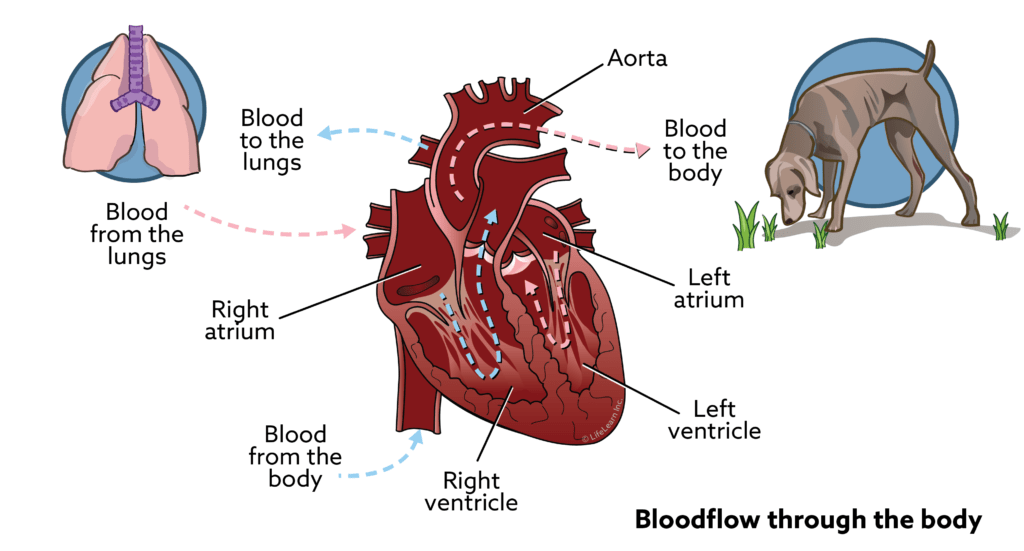What is the ductus arteriosus?
The ductus arteriosus is an opening between the aorta and the pulmonary artery, the two main blood vessels leading from the heart. It is normally present during fetal development.

What is its purpose?
Before birth, the developing fetus receives all of its oxygen through the placenta, and the developing lungs are deflated. As part of fetal circulation, the ductus arteriosus allows the majority of circulating blood to bypass the lungs. Therefore, while the fetus is in the uterus, the ductus arteriosus is normally open, or “patent”.
When the newborn puppy takes its first breath, the ductus is stimulated to close. Closure of the ductus arteriosus ensures that blood will circulate through the inflated lungs and become oxygenated.

What is patent ductus arteriosus?
Patent ductus arteriosus (PDA) is a heart defect that occurs when the ductus arteriosus does not close at birth.
What happens if the ductus arteriosus does not close at birth?
In the normal heart, blood flows from the body into the right side of the heart, and then is pumped through the pulmonary artery into the lungs to be oxygenated. From the lungs, it flows through the pulmonary vein into the left side of the heart. The left side of the heart then pumps the blood through the aorta, distributing oxygen-rich blood to the body. The muscles in the left side of the heart are normally thicker and stronger than those in the right side of the heart. The pressure within the left side of the heart and the aorta is higher than the pressure on the right side and the pulmonary artery and veins. This is because it is harder to pump blood to the entire body than to pump blood through the lungs.

If the ductus arteriosus fails to close properly after birth, that difference in pressure between the pulmonary artery and the aorta means that blood will take the path of least resistance and flow from the aorta through the patent ductus arteriosus and into the pulmonary artery. The pulmonary artery then needlessly recirculates this oxygenated blood back to the lungs. Since less blood is now being pumped into the main circulation through the aorta, the left side of the heart is forced to work harder to meet the demands of the body.
The size of the patent ductus arteriosus defect will determine how much harder the heart must work. If the defect is small, the left side of the heart becomes mildly enlarged (mild left ventricular hypertrophy). If the defect is medium-sized, the left side of the heart becomes moderately enlarged. As the heart enlarges, it is forced to work harder and ultimately this increased work can lead to congestive heart failure (see handout on “Congestive Heart Failure in Dogs”).
In some cases, when the PDA is large, a significant amount of blood will shunt into the lungs, forcing the pulmonary artery, the pulmonary vein, and the right side of the heart to become thicker (called right ventricular hypertrophy) to deal with the excess load of blood. This thickening leads to pulmonary hypertension (elevated blood pressure in the lungs) and may ultimately cause the direction of the shunt to reverse.
What are the signs of a PDA?
A dog that has a small PDA defect may not show any obvious signs of disease. As the PDA increases in size, more blood will be shunted through it, causing more significant signs. These may include difficulty breathing, a loud heart murmur, abnormal pulses, and exercise intolerance. A puppy with a PDA may sleep more than usual, may be stunted in growth, or maybe thinner than average.
As blood continues to shunt through the PDA, it will cause irreversible changes in the heart muscle and eventually may lead to congestive heart failure. If the PDA is significant enough to cause congestive heart failure, signs may also include a heart arrhythmia (abnormal heart beats), increased lung sounds when listened to with a stethoscope, and accumulation of fluid in the lungs and/or abdomen.
When the shunt is very large, the pressure in the pulmonary circulation may continue to increase until it exceeds the pressure in the aorta. If this happens, the shunt may reverse, so that blood returning from the body shortcuts through the aorta before going through the lungs to receive oxygen. If the dog develops this “reverse PDA”, the heart murmur will disappear, and the signs will become severe and debilitating, including abnormal heartbeats, cyanosis (blueness) of the foot pads on the hind legs, collapse of the hind legs when the dog exercises, and weakness or lethargy.
What is the ductus arteriosus?
The ductus arteriosus is an opening between the aorta and the pulmonary artery, the two main blood vessels leading from the heart. It is normally present during fetal development.
Are there any breeds that are affected more often than others?
Patent ductus arteriosus is the most common congenital heart disease in dogs and more common in female dogs. Although any dog breed can be affected by this heart defect, PDA does appear to have a heritable component in smaller dog breeds. Breeds that are reported to have more problems with this defect include American cocker spaniel, Bichon Frise, Chihuahua, Collie, English springer spaniel, German shepherd, Irish setter, Keeshonden, Kerry blue terrier, Labrador retriever, Maltese, Miniature and toy poodle, Newfoundland, Pomeranian, Shetland sheepdog and Yorkshire terrier.
This defect appears to run in families. Affected dogs should not be bred, even if the condition is successfully treated.
How is PDA diagnosed?
A PDA is usually diagnosed when your veterinarian hears a continuous heart murmur during a routine physical examination of your puppy. A continuous murmur is present continuously throughout the entire heart cycle. It is often described as a “machinery murmur” or a “washing machine murmur” because it sounds like water being agitated through the wash cycle. The murmur will be graded on a scale from 1 to 6, with the higher numbers being more severe. If the murmur is pronounced, you may be able to feel a buzzing when you touch the puppy’s chest. This buzzing is called a thrill.
Your veterinarian will recommend chest X-rays (radiographs) to assess the heart and lungs, and an electrocardiogram (ECG) to assess the heart rhythm. Blood tests will show whether other organs are being affected by the abnormal blood flow, or if there are elevated red blood cell values. Red blood cells carry oxygen, and the body attempts to meet its increased oxygen needs by producing more red blood cells.
Echocardiography, or cardiac ultrasound, will be needed to definitively diagnose a PDA. The ultrasonographer will examine a moving image of the heart to assess the degree of enlargement of its walls and the efficiency of its pumping. Doppler echocardiography, which evaluates the direction and speed of blood flow, will be used to help pinpoint the location and size of the shunt and to determine the amount of turbulence associated with the shunt.
Could the signs be caused by something else?
Other complex heart defects can also cause a continuous heart murmur. Echocardiography will usually differentiate the type of defect, helping to determine the appropriate treatment options.
What is the treatment for a PDA?
The goal of treatment for a forward-flowing PDA is to stop the blood flowing through the shunt. Your veterinarian will refer you to a veterinary cardiovascular surgeon, who will determine the optimal treatment for your dog. In some cases, the ductus will be tied off during heart surgery.
In other cases, a less invasive surgical treatment may be an option. The less invasive procedure involves occlusion (blocking) of the ductus arteriosus with either a transarterial coil or a ductal occluder device, which is placed using cardiac catheterization.
Surgical repair should be performed as soon as possible. The longer the surgery is delayed, the more likely it is that irreversible heart damage will occur. If the dog shows signs of heart failure, pre-surgical stabilization will be necessary.
There is no surgical treatment for a reverse PDA. Medical treatment will help manage the symptoms, but a cure is not possible for dogs with a reverse PDA, and it will inevitably be fatal.
What is the success rate for surgical treatment of PDA?
Provided that the condition is treated before heart failure develops, the success rate associated with surgical closure is very high and the prognosis for a normal life after surgery is excellent.
If irreversible heart damage is present before surgery, the dog may require heart medication in the future.
What is the success rate for medical management of a reverse PDA?
If the signs of disease can be controlled with medication, the dog may live comfortably for several years.
What is the prognosis for pets with PDA?
Prompt and appropriate diagnosis and treatment of this congenital, hereditary cardiac disorder is associated with an excellent long-term prognosis. Both standard surgical and minimally invasive transcatheter techniques can successfully treat the condition as long as it hasn’t progressed to a reverse PDA.

| Cookie | Duration | Description |
|---|---|---|
| cookielawinfo-checkbox-analytics | 11 months | This cookie is set by GDPR Cookie Consent plugin. The cookie is used to store the user consent for the cookies in the category "Analytics". |
| cookielawinfo-checkbox-functional | 11 months | The cookie is set by GDPR cookie consent to record the user consent for the cookies in the category "Functional". |
| cookielawinfo-checkbox-necessary | 11 months | This cookie is set by GDPR Cookie Consent plugin. The cookies is used to store the user consent for the cookies in the category "Necessary". |
| cookielawinfo-checkbox-others | 11 months | This cookie is set by GDPR Cookie Consent plugin. The cookie is used to store the user consent for the cookies in the category "Other. |
| cookielawinfo-checkbox-performance | 11 months | This cookie is set by GDPR Cookie Consent plugin. The cookie is used to store the user consent for the cookies in the category "Performance". |
| viewed_cookie_policy | 11 months | The cookie is set by the GDPR Cookie Consent plugin and is used to store whether or not user has consented to the use of cookies. It does not store any personal data. |